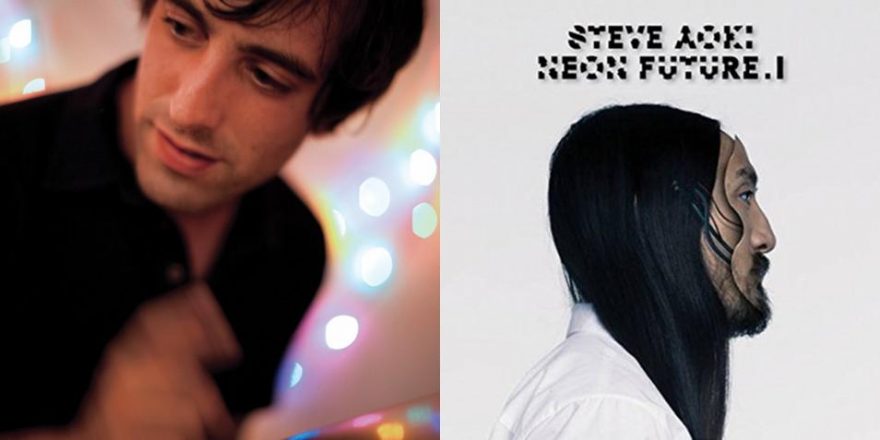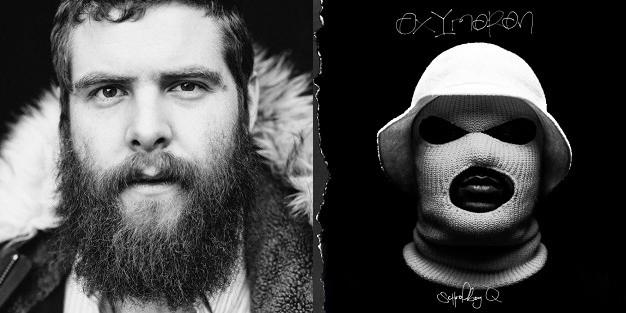I was still a teenager when I first met Steve Aoki in the summer of 1998. My band Cave In was rolling into Santa Barbara under a soft, pink sunset to play at a place called the Pickle Patch, which was essentially the living room of his house.
I remember it was pretty bare-bones in there, which seems about right; it doesn’t make sense to put much of anything inside a small space that gets swarmed by hordes of sweaty bodies multiple times a week. That night, Steve let us crash on the same floor where we’d played, and I think I fell asleep on a bed of drumstick splinters. The next morning, I noticed a four-track recorder stashed in a corner of the room. A friend of mine owned the same model. When I mentioned this to Steve, he actually encouraged me to use it. So I went out to the van and grabbed the acoustic guitar that we brought on tour to kill time. It took less than 10 minutes to record this silly little medley of the Cave In songs “Programmed Behind” and “Crossbearer” before leaving for the next show. You can check them out here, if you like.
I think Cave In played the Pickle Patch maybe one or two more times before it closed. Steve was a gracious host who always seemed more than willing to embrace the friendly chaos of punk and hardcore shows. Shows at the Pickle Patch were always a treat for this East Coaster, who mythologized nearly everything happening in the mid-to-late ’90s California underground music scene.
Something that never gets old for me is learning how people from that same underground music community have since twisted and turned through life in unexpected ways. For a while I’d heard rumblings of Steve’s ventures since those Santa Barbara days, things like “Oh yeah, that dude’s a DJ now” and, more recently, “Supposedly he became a big-time electronic music guy.” Well, that made sense. I only ever knew Steve as someone who liked to throw a party.
Based on some of my own experiences, I know all too well that people can be pretty harsh when a musician, at first glance, appears to just up and abandon their roots. But I also believe it’s impossible to walk away from one thing and not bring some part of it along with you. I’m thinking of John Lennon singing “looking through a glass onion,” and it’s a fitting image here: we are simply and forever the many layers of ourselves that we create. Punk and hardcore is obviously a part of Steve. I was there to see it. As for what he’s since built upon that foundation, I get the impression we’re all invited to participate if we want to.
On that note, I don’t know much about the world of EDM, dubstep or DJs. I guess I’m simply a rocker at heart. As a young man, my dad used to play in bands that covered the Rolling Stones and the Animals. And growing up, there was always a guitar kicking around the house. And there were the Led Zeppelin albums that my music teacher told me to check out. And now, at 35 years old, I’ve been devoted for more than half my life to creating what’s essentially guitar-driven music.
So maybe there’s something odd about me writing about the new Steve Aoki album Neon Future 1, his second official release. The vision seems to be Steve’s, and with a bunch of musical guests in the mix, it’s sort of like an electronic Probot. Regardless, what feels important is simply to give an honest listen to the work of someone from a traceable place in my musical history. It’s also a means of looking at myself, assessing my own trajectory through the mind and ears of that person.
In the end, I found my own ways of identifying with Steve’s music. Like how the title track opens with a nod, to my ears, to “Just One Fix” by Ministry. And there’s this lyric (courtesy of guest singer Patrick Stump of Fallout Boy) in the song “Back to Earth” that appeals to my inner space-rocker: “And you know I’ve found the dust to be resilient/And we’re the dirtiest of the dirt.” And some point, I had myself convinced that Mike Patton was singing the sweet textures buried beneath rolling synth waves in “Rage the Night Away” because the vocal timbre and melodic sensibility of the production is almost identical to some of the tender moments from Mr. Bungle’s 1999 album California.
“Afroki” provides a welcome change of pace: to hear a woman (guest Bonnie McKee) sing about feeling vulnerable is such a simple concept, yet it makes a big impact after the hedonistic vibes of the previous couple of tracks. And damn, she gets all up there with her voice! She’s pushing air like a champ, singing, “I’m not afraid any…” then suddenly ascending to the word “more,” like Falkor from The Never Ending Story whistling above the clouds.
While listening to this album, I found myself grazing, picking out little bits that struck me, focusing on all the inventive production tricks and strange vocal sounds. But I know I’m probably missing something. Could it be that this stuff is made for cushioning crowds in a large venue? Is the solitary listening experience only secondary to that?
If I were to take a lesson from punk and hardcore, I’d say that the best way for me to connect the dots here is to immerse myself in Steve doing his thing live, and then it will make sense. Maybe I’ll find more to grasp on to that way. Considering the contribution he made to my world, it’s only fair that I should venture out to see the man he’s become today.









